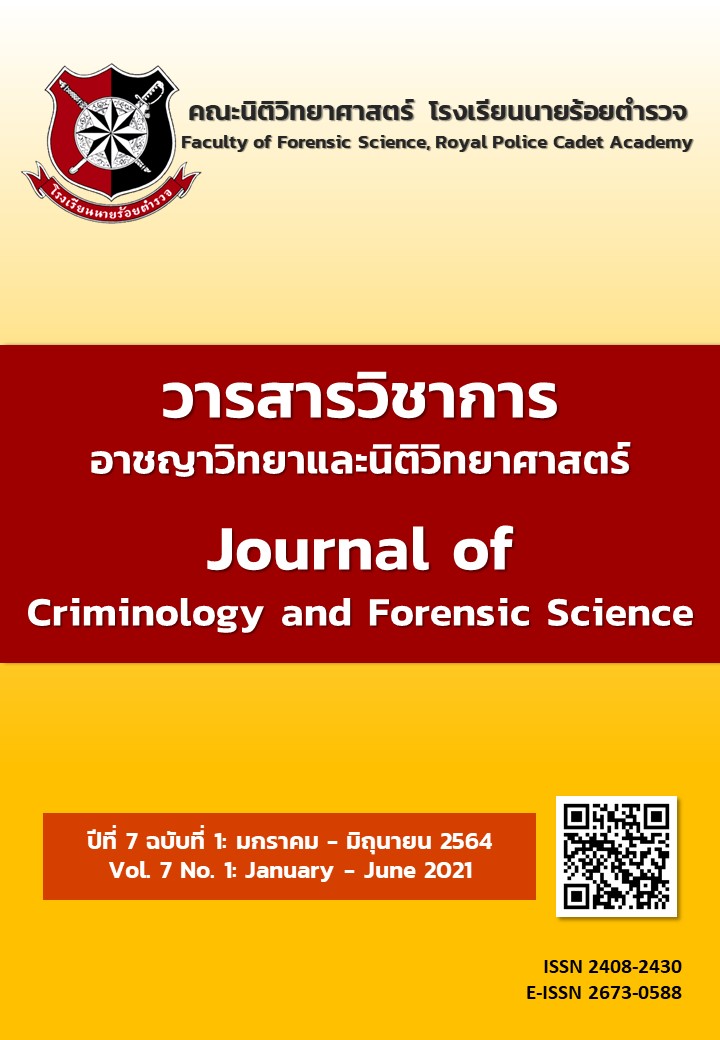การวิเคราะห์ข้อมูลแบบหลายมิติสำหรับจำแนกประเภทผู้กระทำความผิดบนโซเชียลมีเดียโดยใช้เทคนิคทางบิ๊กดาต้า
Main Article Content
บทคัดย่อ
งานวิจัยเรื่องนี้มีวัตถุประสงค์เพื่อ 1) เพื่อศึกษาลักษณะข้อมูลในมิติของข้อมูลส่วนบุคคล ข้อมูลเชิงพฤติกรรม และข้อมูลเชิงการแสดงความคิดเห็นของผู้กระทำความผิดที่อยู่บนโซเชียลมีเดีย 2) สืบค้น ติดตาม เก็บบันทึก และวิเคราะห์ข้อมูลของผู้กระทำความผิดที่อยู่บนโซเชียลมีเดียด้วยเทคนิคทางบิ๊กดาต้าในเชิงสถิติ และ 3) จำแนกประเภทของผู้กระทำความผิดบนโซเชียลมีเดียด้วยเทคนิคทางบิ๊กดาต้าในเชิงสถิติ โดยผลการวิจัยพบว่าข้อมูลบัญชีของผู้กระทำความผิดบนโซเชียลมีเดียประเภททวิตเตอร์มีทั้งสิ้นจำนวน 4,974 บัญชี ซึ่งเมื่อนับคำสำคัญจากแฮชแท็กของทุกบัญชีพบว่ามีคำสำคัญทั้งหมดจำนวน 1,035 คำ ผลจากการประมวลผลโปรแกรมเพื่อจำแนกกลุ่มผู้กระทำความผิดบนโซเชียลมีเดีย พบว่ากลุ่มของผู้กระทำความผิดบนโซเชียลมีเดียประเภททวิตเตอร์ (Twitter) ประกอบไปด้วย 11 กลุ่ม โดยกลุ่มของสินค้าละเมิดลิขสิทธิ์มีมากที่สุด คิดเป็นร้อยละ 19.44 รองลงมาคือ ซื้อขายวัตถุลามกอนาจารร้อยละ 16.32 ค้าประเวณีร้อยละ 13.73 ซื้อขายอาวุธปืนผิดกฎหมายร้อยละ 9.95 พนันออนไลน์ร้อยละ 9.17 เงินกู้นอกระบบร้อยละ 7.64 ซื้อขายยาผิดกฎหมายร้อยละ 6.94 ปลอมแปลงเอกสาร ร้อยละ 5.19 ยาเสพติดร้อยละ 4.70 อาชญากรรมอื่น ๆ ร้อยละ 4.66 และ ซื้อขายสัตว์ป่าคุ้มครองร้อยละ 2.25 ตามลำดับ ในขณะที่ผลของการหาความสัมพันธ์ของข้อมูลผู้กระทำความผิดบนโซเชียลมีเดียโดยใช้เครื่องมืออัจฉริยะแบบโอเพนซอร์สด้วยโปรแกรมมัลทีโก (Maltego) นั้น สามารถนำไปใช้ในการสืบสวนหาตัวผู้กระทำความผิดในขั้นตอนการทำงานของเจ้าหน้าที่ตำรวจได้อย่างมีประสิทธิภาพ
Article Details

อนุญาตภายใต้เงื่อนไข Creative Commons Attribution-NonCommercial-NoDerivatives 4.0 International License.
เนื้อหาและข้อมูลในบทความที่ลงตีพิมพ์ใน วารสารวิชาการอาชญาวิทยาและนิติวิทยาศาสตร์ โรงเรียนนายร้อยตำรวจ ถิอว่าเป็นข้อคิดเห็นและความรั้บผิดชอบของผู้เขียนบทความโดยตรงซึ่งกองบรรณาธิการวารสาร ไม่จำเป็นต้องเห็นด้วยหรือรับผิดชอบใดๆ
บทความ ข้อมูล เนื้อหา รูปภาพ ฯลฯ ที่ได้รับการตีพิมพ์ใน วารสารวิชาการอาชญาวิทยาและนิติวิทยาศาสตร์ ถือว่าเป็นลิขสิทธิ์ของวารสาร วารสารวิชาการอาชญาวิทยาและนิติวิทยาศาสตร์ หากบุคคลหรือหน่วยงานใดต้องการนำทั้งหมดหรือส่วนหนึ่งส่วนใดไปเผยแพร่ต่อหรือเพื่อกระทำการใดๆ จะต้องได้รับอนุญาตเป็นลายลักษณ์อักษรจาก วารสารวิชาการอาชญาวิทยาและนิติวิทยาศาสตร์ ก่อนเท่านั้น
เอกสารอ้างอิง
Chena, R and Sharmaa, S. K. (2013). Understanding Member Use of Social Networking Sites from a Risk Perspective. Procedia Technology, 9, 331-339.
Cooper, A. (2016). Using social media for social research: An introduction. Social Media Research Group, Retrieved September 2, 2020. From https://assets.publishing.service.gov.uk/government/uploads/system/uploads/attachment_data/file/524750/GSR_Social_Media_Research_Guidance_Using_social_media_for_social_research.pdf.
Hassan, N. (2018). A primer introduction to Open-Source Intelligence Gathering (OSINT) gathering and analysis. Retrieved September 2, 2020. From http://www.OSINT.link.
Hayes, D. R. and Cappa, F. (2018). Open-source intelligence for risk assessment. Business Horizons, 61(5), 689-697.
Khemakapasiddhi, C., Nurarak, P., Pumsorn, P., Ramungtong, P., Thongyod, E., and Keardsri, W. (2019). Personal Relationship Analysis of Prostitution and Human Trafficking Data on Twitter using Open-Source Intelligence Tools. Senior Research Project, Bachelor of Public Administration Program in Police Science, Royal Police Cadet Academy. (In Thai).
Riek, M. and Böhme, R. (2014). Understanding the influence of cybercrime risk on the e-service adoption of European Internet users. Proceedings of 13th Annual Workshop on the Economic of Information Security.
Sathyadevan, S., Devan M. S., and Gangadharan, S. (2014). Crime Analysis and Prediction Using Data Mining. Proceedings of First International Conference on Networks & Soft Computing (ICNSC).
Smitherson, D. (2012). Impact of Cyber Crime and Security on Social Media. Social Media Today, Retrieved September 2, 2020. From https://www.socialmediatoday.com/content/impact-cyber-crime-and-security-social-media.
Socialbakers. (2020). Free Social Media Statistics. Retrieved September 2, 2020. From https://www.socialbakers .com/statistics/.
UNHCR. (2017). Social Media and Forced Displacement: Big Data Analytics & Machine-Learning. Retrieved September 2, 2020. from https://www.unhcr.org/innovation/wp-content/uploads/2017/09/FINAL-White-Paper.pdf
Williams, M. L., Burnap, P. and Sloan, L. (2017). Crime Sensing with Big Data: The Affordances and Limitations of using Open Source Communications to Estimate Crime Patterns. British Journal of Criminology, 57 (2), 320-340.


